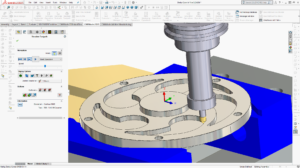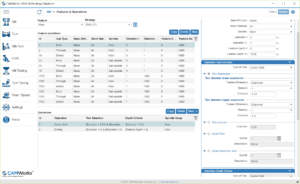Small machine shops are under pressure to maximize every resource to run lean and stay competitive, and their CADCAM system should be no exception. SOLIDWORKS CAM and CAMWorks is a great solution that is affordable for your small machine shop and provides powerful programming for any job. Let’s explore why CAMWorks is a great tool, and what it does.
SOLIDWORKS CAM is included at no additional charge in every copy of SOLIDWORKS, from version 2018 and later on subscription. Just go to the SOLIDWORKS add-in menu and install SOLIDWORKS CAM. It includes 2.5 axis milling and basic 3 axis milling for area clear roughing as well as flat area and Z-level finishing. If you need more functionality now or as time goes on, you can step up incrementally with different levels of SOLIDWORKS CAM and CAMWorks as your business expands and grows.
One of the resources we all try to maximize is time, and an integrated CADCAM system can save you a lot of time. But first, let’s look at what an integrated CADCAM system is. Integrated CADCAM is a system the gives you part models with both design and manufacturing stored in the same file. With integrated CADCAM, there is no need to create your part in a separate CAD system with one file format and then transfer that CAD file into a different CAM system to generate the toolpaths and G-code–ending up with 2 different part models. With integrated CADCAM, your CAM system lives within your CAD system and this provides several benefits:
Eliminate part file translation errors
With standalone CAD and CAM systems, part models need to be transferred from your CAD system to your CAM system. This is typically accomplished by using a variety of standard file types – STEP, ACIS, DXF/DWG, IGES, etc. However, when the part model is pulled into the CAM system, there is often data that is lost or incomplete. This requires you to take extra time finding the translation errors and cleaning up the part model to get it ready for machining, re-programming any sections of the part with lost data.
With integrated CADCAM you don’t need to switch between two systems or worry about importing and exporting errors. There is no wasted time trying to get your CAD model and your CAM model to match. Toolpaths and G-code are generated straight from the original CAD model so there is no lost data. If changes are made to the design file, these are automatically reflected in the manufacturing data and the toolpaths and G-code are updated accordingly.
Access to powerful CAD tools along with CAM functionality
Another benefit of using integrated CADCAM is getting the best of both worlds in one system. Several standalone CAM systems have some level of CAD functionality built in, but CAM systems are designed to focus on generating toolpaths and G-code, so CAD functionality is a secondary focus. With an integrated CADCAM system like SOLIDWORKS CAM and CAMWorks, you have access to a full range of powerful solid modeling tools. Not only is SOLIDWORKS one of the top CAD systems in the industry, it also gives you access to an abundance of third-party add-ins to help with any unique product design needs. Combine that with the breadth of CAM functionality in CAMWorks, and you have the tools needed to easily take any part from design to cutting chips.
Utilize automation for high output and consistent quality
Allowing automation to complete redundant tasks saves time and reduces problems caused by human error. The ideal balance is achieved when we can use automation to provide these benefits and still maintain control to adjust things when needed. The same is true for automation in CAM software.

When affordable desktop computers were introduced, CADCAM software quickly followed, but part programming relied heavily on the machinist’s knowledge and input. As technology has advanced, CADCAM is able to provide more efficient levels of automation to accelerate the manufacturing process and produce high quality results. But even today, several CAM systems have not yet evolved to take full advantage of the technology available. They remain process-based and still require extensive amounts input and time to complete part programming.
In a process-based CAM system, the programmer creates toolpaths by entering each machining option. They select a tool for the roughing operations and then select a 2D profile or geometry chain to define the part feature they are machining. They enter the speeds and feeds, dimensions and additional cutting parameters. Then they start the process over again for the finishing operations.
A feature-based and knowledge-based CAM system creates toolpaths by identifying features in a part, such as a tapped hole or a tapered wall pocket. Instead of having to manually enter the criteria for each operation, your CAM software has the intelligence to know what is needed to create the features in your part. It will automatically identify the roughing and finishing operations, select the appropriate tool from your tool crib, calculate the optimum feed and speed rates, generate the toolpaths and then show you the simulation and G-code to assure the machining goes smoothly. With the added functionality of automatic feature recognition in an integrated CADCAM system like SOLIDWORKS CAM and CAMWorks, your part literally goes from CAD model to G-code in a matter of minutes.

Now take this a step further with CAMWorks Technology Database or TechDB. With all that automation we just talked about, there are often settings and processes that can benefit from a little bit of fine-tuning or may need to be edited slightly to meet the specific needs of your machine shop or business. With CAMWorks TechDB, you can save all of these fine-tuning settings in an automation database specific to your shop, and then reuse them the next time you have those same part requirements. This helps you maintain consistency in your parts and with this level of automation, you’re saving time and increasing your output, which is a critical need for small machine shops.
